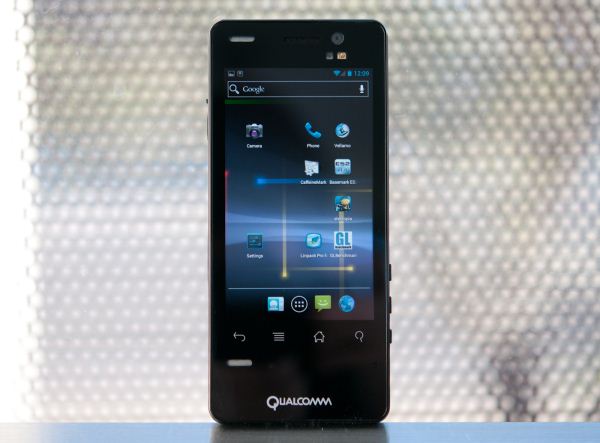Qualcomm Snapdragon S4 (Krait) Performance Preview - 1.5 GHz MSM8960 MDP and Adreno 225 Benchmarks
by Brian Klug & Anand Lal Shimpi on February 21, 2012 3:01 AM EST- Posted in
- Smartphones
- Snapdragon
- Qualcomm
- Adreno
- Krait
- Mobile
Final Words
It goes without saying that MSM8960 is a hugely important SoC release for Qualcomm. It's the first release with Qualcomm's new Krait CPU architecture, an entirely new cellular baseband with support for nearly every air interface, and is manufactured on TSMC's 28nm process. It says something that we're able to hold 28nm TSMC silicon in our hands in the form of the MDP, and it's only a matter of time before we start seeing Krait show up in devices in 2012.
We've gone over basically all of the benchmarks available to us on Android right now, and yet subjective performance impressions are still valuable. The MDP8960 is the absolute fastest we've seen Ice Cream Sandwich thus far - the UI is absolutely butter smooth everywhere, and web browsing in either Chrome or the stock Android Browser is also the smoothest we've seen it. There's no stutter bringing up the application switcher, or taking screenshots, two places that 4.0.3 still drops frames on the Galaxy Nexus.
Krait offers another generational leap in mobile SoC performance. The range of impact depends entirely on the workload but it's safe to say that it's noticeable. The GPU side of the equation has been improved tremendously as well, although that's mostly a function of 28nm enabling a very high clock speed for Qualcomm's Adreno 225. We are eager to see what the Adreno 3xx GPUs that will pair up with future Krait SoCs can do.
The big unknowns today are power consumption and the performance of shipping devices. While we were able to provide power numbers using Qualcomm's handy Trepn tool, we couldn't produce a reference point on older silicon. The move to 28nm and a second generation of cellular basebands has generally been heralded as being the answer to our battery life issues, particularly with LTE. It remains to be seen just how much of an improvement we'll see there. Knowing how much power MSM8960's cellular architecture uses is especially relevant when you consider that MDM9615 includes the exact same modem as MSM8960.
These initial results look extremely promising, however. Krait based devices should begin shipping sometime next quarter, the wait is almost over.











86 Comments
View All Comments
ssj4Gogeta - Tuesday, February 21, 2012 - link
I think he meant lower compared to the 720p GLBenchmark where the A5 wins.zanon - Tuesday, February 21, 2012 - link
I agree the wording is a bit awkward there since they are both driving identical numbers of pixels. If he meant to compare it to the earlier 720p results it'd probably be better to make that explicit.jjj - Tuesday, February 21, 2012 - link
Looks like it's faster than Tegra 3 and with single threaded perf certainly much better the only remaining big question is power consumption.Malih - Tuesday, February 21, 2012 - link
I've been my old android device that comes with Android 1.6, and Cyanogenmod-ded to Gingerbread (it's not so responsive when running more than one app), because I need the new version of the Gmail app.Malih - Tuesday, February 21, 2012 - link
correction: I've been *using* my old...In short: it looks like I'll be waiting in line for a smartphone with this SoC
Zingam - Tuesday, February 21, 2012 - link
I haven't been impressed by a CPU/GPU for years but this thing looks amazing! If they manage to go on like that we'll soon have a true ARM desktop experience.Great job! I wish now they support the latest DirectX/OpenGL/OpenCL/OpenVG etc. stuff and we'll have it!!! It is unimaginable what ARM based SoCs would deliver when the time for 14nm comes.
Torrijos - Tuesday, February 21, 2012 - link
Since both devices actually render the same amount of pixel but with different aspect ratio, would it be possible, that the performance hit seen for the iPhone 4S, is the result of graphics rendered in a standard aspect ratio (16:9 or something else) then having to be transformed to fit the particular screen?cosminmcm - Tuesday, February 21, 2012 - link
Maybe it's because at the lower resolution the faster CPU on the Krait (newer architecture with higher clocks) matters more than the faster GPU on the A5. When the resolution grows, the difference between the GPU becomes more apparent.LetsGo - Tuesday, February 21, 2012 - link
What difference?http://blogs.unity3d.com/wp-content/uploads/2011/0...
metafor - Tuesday, February 21, 2012 - link
Considering Apple controls the entire software stack and the A5 silicon, it'd be pretty stupid of them to do that. And if you look at how performance scales between the iPad (4:3) and iPhone (16:9), there's no slowdown due to aspect ratio.